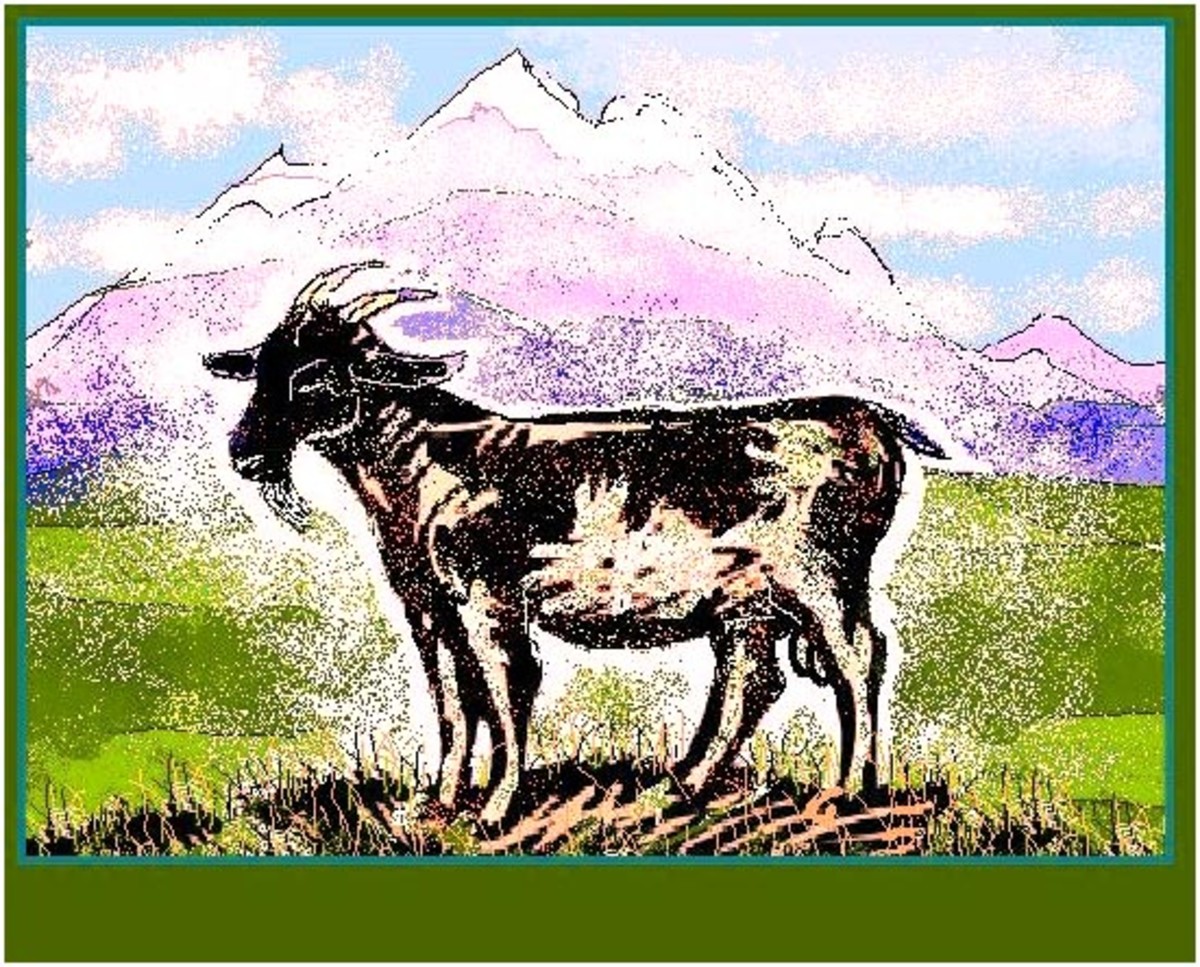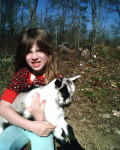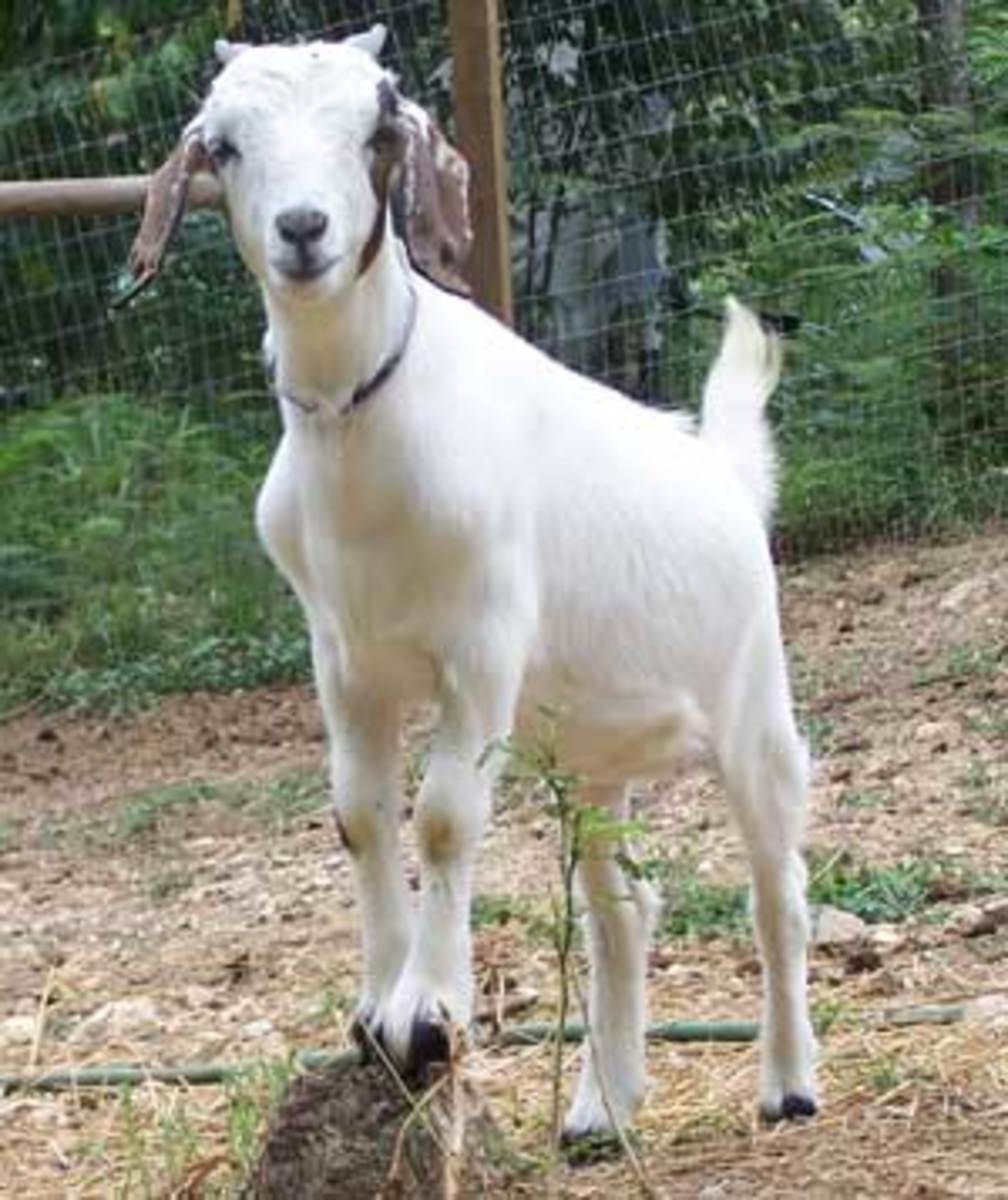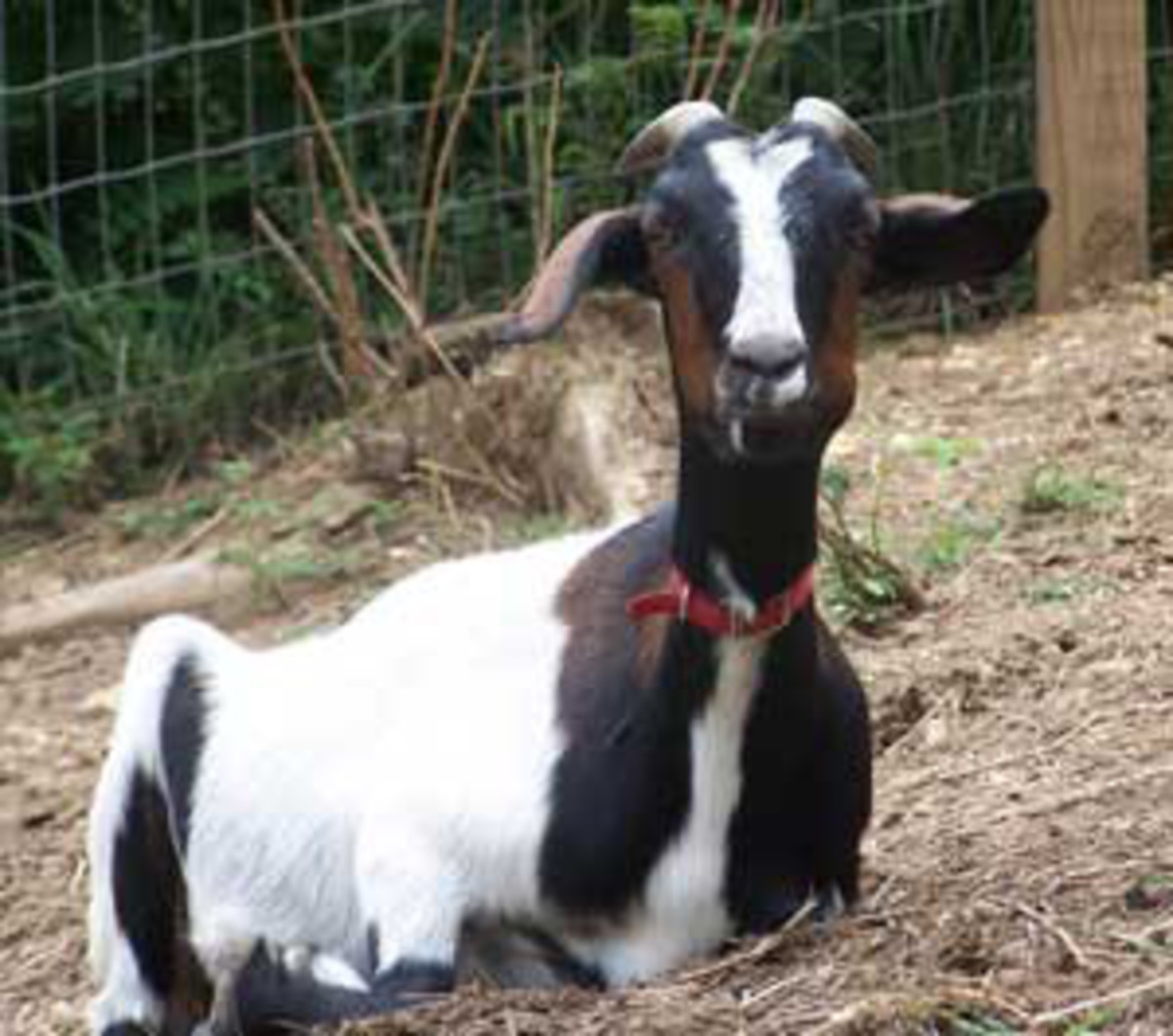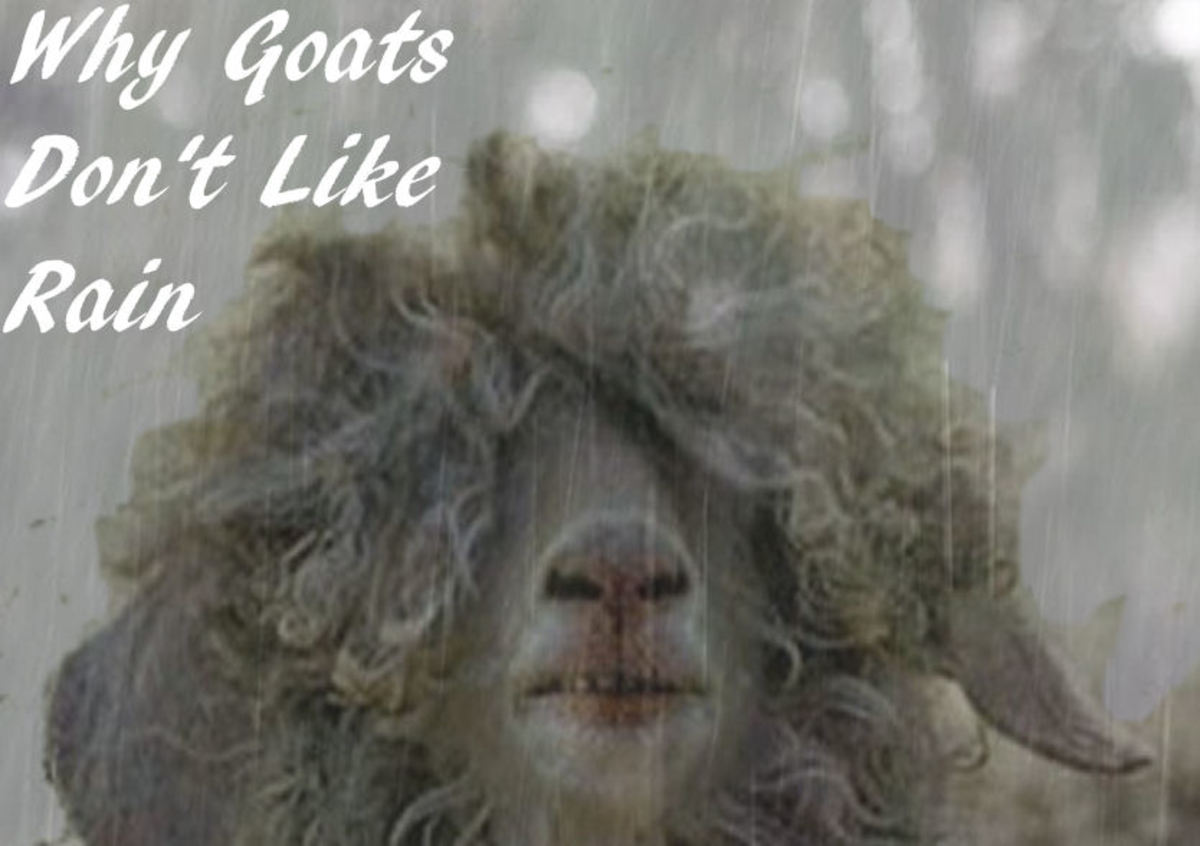Feeding Meat Goats
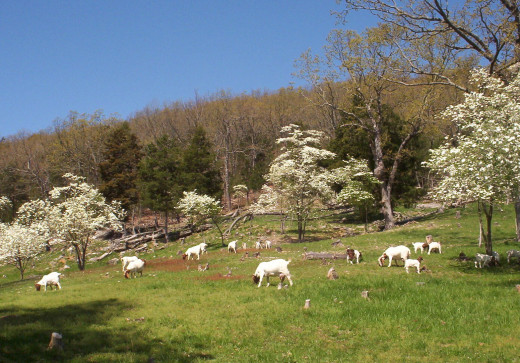
- Langston University Goat & Research Extension
Dr. Steve Hart's "Introduction to Goat Nutrition" - "Feed Composition Tables"
published by the University of Missouri
Basic Nutrition for Meat Goats
The most efficient way to feed goats is to let them harvest their own feed from pasture forages. The cost of the equipment and labor needed to harvest and store feed is high. The cost of buying feed from a feed store is even higher. Thus it is very important for meat goat producers to establish and maintain good quality pastures for their goats. If the quality of pastures is high, the producer will not need to buy expensive feed supplements. Goats on good quality pastures will also be healthier, and their kids will grow faster. If pasture quality is high, with plenty of high protein legumes, kids do not need to be creep fed.
One can obtain a basic knowledge of goat nutrition from Dr. Steve Hart's "Introduction to Goat Nutrition," available on the Langston University web site. This article, together with the goat nutritional requirement data available on the Langston web site, can be used to formulate healthy rations for your goats.
In addition to knowing the nutritional requirements of goats, one also needs to know the nutrients available in the feed one is using. For purchased feed this information is usually available on the feed bag or the tag attached to the bag. For home-grown feed, for hay, and for pasture forages, average values can be found in "Feed Composition Tables" published by the University of Missouri. One can also get hay and feeds tested for composition. Check with your Agricultural Extension Service for the availability of these tests.
When feeding a herd of meat goats it can be difficult to control how much feed each goat is getting. We have found that the best way to do this is to feed enough feed per feeding so each goat gets to eat its fill. This is usually about two pounds per goat, per feeding. If you feed less than this amount the more aggressive goats will get all the feed, and the more timid goats won't get any. If you want to feed one pound per goat per day, just feed two pounds per goat every other day. To avoid digestive problems from the goats eating too much concentrate at one time, make sure the feed has at least 18% fiber. We always feed pasture and/or hay free choice.
Do not feed goats any feed that has the words goat or horse on the bag. It is too expensive. Cattle feeds work well for goats.
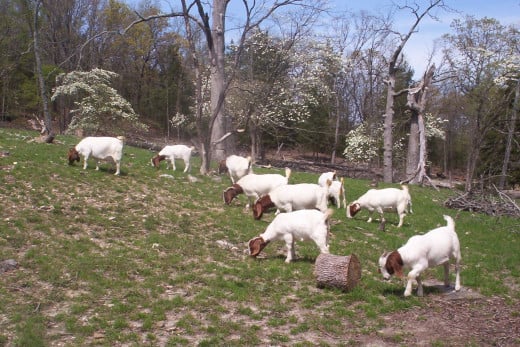
Minerals for Meat Goats
Meat goats need to have certain minerals in order to stay healthy, to grow normally, to reproduce, and to have normal offspring. Minerals required by goats can be grouped into two categories, based on the amounts needed in the diet. Macro minerals are needed in small quantities, and trace mineral are needed in very small quantities. An article, by Dr. Steve Hart, on the Langston University website, lists seven macro minerals and eight trace mineral that are required by goats. Meat goat producers do not need to know what these minerals are and how much is needed by goats since the major feed manufactures produce mineral supplements for goats, cattle, and sheep that contain all of the needed minerals at recommended levels for the areas in which these supplements are sold (the levels needed for some minerals depend on mineral levels in the soils at the location.) If fed free choice, goats will eat the right amounts to meet their mineral needs. These amounts will vary depending on the forages and feeds available to the goats. We prefer to use loose minerals because they are easier for the goats to eat and, if fed in a properly designed mineral feeder, will cause less contamination with goat manure. Goats like to paw at mineral blocks with their feet, and their feet are always full of goat manure. Goat manure is contaminated with internal parasite larva and eggs.
While good mineral supplements are very expensive per pound, goats will only need and eat very small amounts of them. It does not cost very much to feed a high-phosphorus, loose, cattle mineral to goats free choice. We have been doing this for forty-eight years with very good results. The mineral requirements of cattle and goats are the same, but cattle minerals are much less expensive than goat minerals. Do not use sheep minerals for goats. Sheep minerals do not have enough copper for goats. The amount of copper needed by goats and cattle would be toxic to sheep.
The ratio of calcium (Ca) to phosphorus (P) in the diet of a goat is very important. It needs to be two parts calcium to one part phosphorus. This is a Ca to P ratio of 2 to 1. Remember this ratio is for the goat's total diet, not for the mineral supplement. Limestone is the main source of calcium for feed manufactures. Since limestone is cheaper than other feed ingredients and most grains and protein supplements have a lower than 2 to 1 ratio of Ca to P, most manufactured feeds have their Ca to P ratios adjusted to 2 to 1 by adding limestone. Thus manufactured feeds are neutral for Ca to P ratio. If a goat’s entire diet consists of manufactured feed (not a good way to feed goats) one might feed a mineral supplement with a 2 to 1 ratio, but check the feed label first because the feed may already have all the minerals that goats need added to it.
Most legumes (alfalfa, white clover, red clover, and lespedeza) have a six to one, calcium to phosphorus ratio. Most grasses have a two to one ratio. Legumes remove nitrogen from the air and add it to the soil. Legumes are high in protein and so are grasses growing with legumes. It is good to have legumes in pastures and hay, but goats fed legumes need a high phosphorus mineral supplement. Cattle, which are natural grazers, can tolerate higher calcium to phosphorus ratios than goats, which are natural browsers. Goats will not eat white clover unless they have a high phosphorus mineral supplement free choice. We use a high phosphorus cattle mineral that is twelve percent calcium and twelve percent phosphorus (a 1 to 1 ratio.) We feed it free choice allowing the goats to balance their own Ca to P ratios. How much they eat depends on the types of forages they are eating.
It is reported that too much phosphorus, relative to the calcium, in the diet of goats, can cause renal calculi (kidney stones.) In wethers and bucks these stones get lodged in the urethra often causing death. Our experience with feeding a high phosphorus mineral, free choice, for forty-eight years has been that, as long as the goats have plenty of good quality forages free choice, plenty of clean water, and we do not feed any concentrate feeds containing less than eighteen percent fiber, our goats do not have any problems with renal calculi.
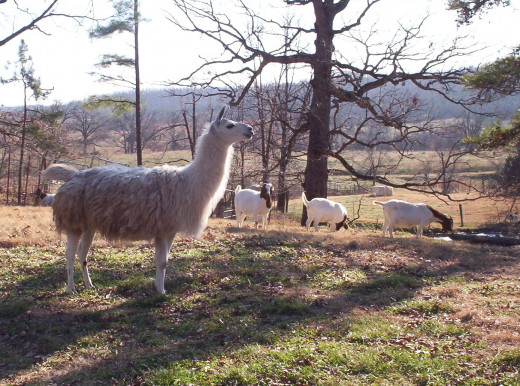

Feeding Acorns to Meat Goats
Acorns can be a valuable source of feed for meat goats. Our goats have free access to acorns every fall. They gain weight and their coats start blooming when the acorns are falling. Acorns definitely improve their health. The tannins in acorns probably help to control internal parasites in goats. In northern Arkansas the acorns start falling in late September, several weeks before we turn the bucks in with the does for breeding. If the does are gaining weight before being bred, they will have more twins and triplets. This is called flushing. Many goat producers feed grain to flush their does. We prefer to use acorns. Our goats kid in mid March and we sell our slaughter kids in December after they have been fattened on acorns.
Acorns can be toxic to cattle, but goats and deer can eat acorns without any toxic effects. We let our goats eat all the acorns they wish. We have been doing this for forty-eight years and have never had one show any signs of being poisoned. They also have plenty of good quality grass/legume pasture so they are never forced to eat only acorns. It is reported that green acorns are more toxic than ripe ones. We notice that our goats will not eat green acorns. It is our experience that goats will not eat anything that is toxic unless they are forced to because they have nothing else to eat. There are many false reports, in the literature and on the internet, about acorns being toxic to goats. The problem is that very few veterinarians and agricultural extension agents have ever raised goats. They just assume that goats are the same as cattle and sheep, but they are not!
It is also reported in the literature that oak leaves are toxic to goats, but they are not. We use goats to clean up and kill oak sprouts. We also cut oak trees for firewood and let the goats eat the leaves. We do this during hot dry weather when pastures are short. When pastures are short one can also sell oak logs for lumber, allowing the goats to eat the leaves. Goats do real well on oak leaves. Again we believe that the tannins in oak leaves help to control internal parasites.
100 Gallon Stock Watering Tank

Since acorns can be toxic to cattle, meat goats can be used to clean up acorns in pastures for cattle. It is reported that acorns dry up milk production in cows. Since our meat goats are usually not milking when acorns are falling we have no information on the effects of acorns on milk production in goats. Even when we were milking dairy goats our goats were too close to the ends of their lactations when acorns started falling for us to be able to tell if the acorns had any effect on milk production.
Purchasing feed for goats is very expensive and eats into profits from raising goats. Even raising and harvesting feed is expensive when considering the cost of equipment, fuel, and labor. Good quality pastures along with acorns is the most efficient way to feed goats.
The Feeders we Use
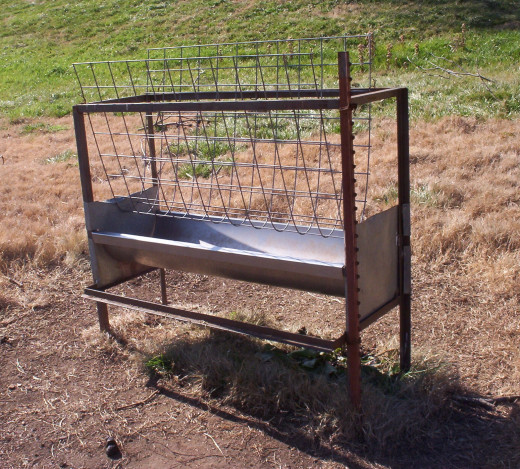
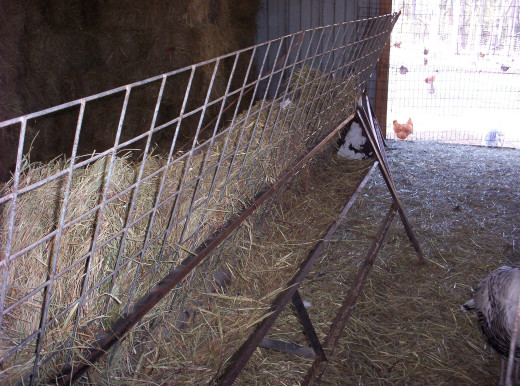
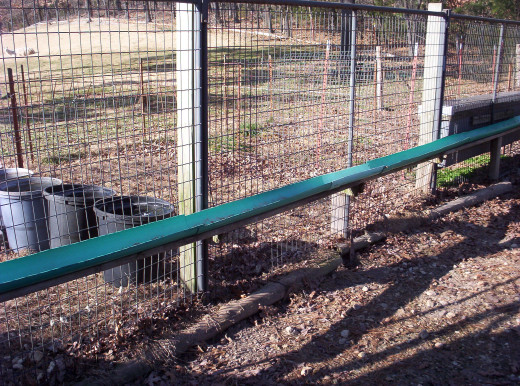
Goat Feeder with a Hay Rack

Feeders for Meat Goats
When feeding goats it is very important to protect the feed from contamination with goat manure to avoid internal parasites. This can be done by making sure feeders are about twenty four inches off the ground, and a bar, about 14 inches off the ground, is provided for smaller goats to prop their front feet on while eating. Such feeders are called flex feeders because they force younger goats to flex their loin, rump, and leg muscles while eating. This is important for show goats. Feeders should be built in a way that goats cannot jump up and stand or lay in the feeders.
Feeders can be very expensive to buy. They are a lot cheaper to build. Ken does not weld but our grandsons do. One can also hire high school FFA members to make feeders in their welding classes.
Twenty gallon garbage cans make good water tanks for goats. A block or rock alongside will allow smaller goats to reach the water. Ten years ago we were able to buy them for five dollars each and they lasted three years, but today they cost twenty dollars each and they only last a few months. We switched to using 100 gallon stock watering tanks. Five gallons buckets with water are placed inside the creep feeders for small kids. We always put two or more gold fish in each water tank. They eat the mosquito larva and help control algae.
Goats need lots of exercise to stay healthy and avoid kidding problems. If one does all of the feeding and watering at the barn in winter, the goats will get lazy. We feed at the far end of the pasture when the weather is good. Using portable feeders and moving them often helps prevent damage to pasture plants. Feeding the goats at the far end of the pasture also reduces the amount of manure that needs to be cleaned out of the barn in spring.

